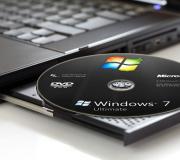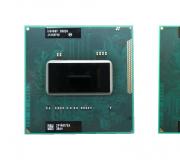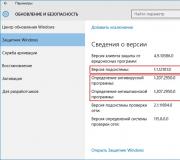How to change the file system on a disk with fat32 ntfs. How to change the file system of a disk or flash drive without formatting. Converting the FAT32 file system to NTFS
Did you know that the type of file system affects the capabilities of your flash drive? So under FAT32 the maximum file size can be 4 GB, only NTFS works with larger files. And if the flash drive is in EXT-2 format, then it will not work in Windows. Therefore, some users have a question about changing the file system on a USB flash drive.
This can be done in several fairly simple ways. Some of them are to use standard tools operating system, and to use others, you need to download additional software. But first things first.
Method 1: HP USB Disk Storage Format
This utility is easy to use and helps in cases where normal formatting Windows tools does not work due to wear and tear on the flash drive.
Before using the utility, be sure to save the necessary information from the flash drive to another device. Then do this:

Method 2: Standard formatting
Before performing any operations, take a simple action: if the drive contains the necessary information, then copy it to another medium. Then do the following:


That's all, the process of formatting, and therefore changing the file system, is over!
Method 3: Convert utility
This utility allows you to fix the file system type on a USB drive without destroying the information. It is included with the Windows OS and is invoked through the command line.

As a result, you will get a USB flash drive with a new file system.
If you want to reverse the process: change file system from NTFS to FAT32, then you need to type this in the command line:
convert g: / fs: ntfs / nosecurity / x
There are some peculiarities when working with this method. It is here's what:
- It is recommended that you check the drive for errors before converting. This is required to avoid mistakes. "SRC" when executing the utility.
- To convert, you need free space on the USB flash drive, otherwise the process will stop and a message will appear "... Not enough disk space for conversion Conversion F failed: was not converted to NTFS".
- If there were applications on the flash drive that require registration, then most likely the registration will be lost.
When converting from NTFS to FAT32, defragmentation will be time consuming.
Once you understand the file systems, you can easily modify them on a USB flash drive. And the problems when the user cannot download the movie in HD quality or the old device does not support the format of the modern USB media will be solved. Good luck in job!
Very often, users are faced with the fact that a file does not want to be written to a USB flash drive, displaying a message that the allowable file size exceeds 4GB. This is due to the fact that the USB flash drive has the FAT32 file system, which is not intended for large files.
Read below how to change the file system.
How to change the file system of a flash drive to NTFS
There are at least three easy ways change the file system on the flash drive. Let's consider each of them in more detail.
Changing the file system by formatting
This method is the easiest of all. We transfer all the necessary files to the computer, and then select "Format" in the flash drive menu. In the window that opens, change FAT32 to NTFS and start formatting. When finished, you will receive a USB flash drive with a new file system.
Change the file system without formatting
You can also change the file system without transferring data or formatting. To do this, go to Start - Run - write the word "cmd" - click OK. After these manipulations, the command line will open, where we write the following:
- CONVERT E: / FS: NTFS / NoSecurity / X
where E: - the letter denoting the location of the flash drive.
After that, the program will be executed and the flash drive will receive a new file system. This will leave the files in place.
Changing the file system using the program
You can also change the file system using the HP USB Disk Storage Format Tool. Before starting the process, it is important to copy all the information to the hard drive from the USB flash drive.
However, there is no point in using this program if you can just format the USB flash drive.
If everything is quite simple with a flash drive, then changing the file system of the local disk will cause certain difficulties. Read about it below.
How to change the file system of a disk
With a local disk, everything is a little more complicated, because a lot of your files are stored on it, which are often not possible to transfer. There are also several ways to solve the problem here.
Changing the file system of the disk by formatting
Just like with a flash drive, local disk can be formatted. This is also done through the context menu, where you need to click "Format". The interface will be similar to a USB flash drive. We select the file system and format.
It is important to understand that this will simply erase all files on the local disk. Therefore, before doing this, it is advisable to transfer everything to another local disk or removable media.
Change the disk file system without formatting
And here everything happens in exactly the same way as in the case of a flash drive:
- Open Start, click "Run".
- In the window that opens, enter "Cmd", which will bring up the command line.
- In it we enter the command: CONVERT D: / FS: NTFS / NoSecurity / X, where D: is the address of the local disk.
- We are enjoying the conversion process.
After completing the process, you must also defragment the disk in order to combine parts of the programs in one space hard disk. This will increase productivity.
It is important to understand that transferring a local disk with Windows recorded on it can adversely affect the performance of your computer. Therefore, you can leave such a local disk in the old file system. It won't get any worse. And when you need to reinstall the OS, then you can specify a new file system in the installer and the process will go through automatically.
Modern mobile devices, as a rule, can only work with flash drives and disks in FAT32 and are not compatible with the NTFS file system. At the same time, Windows, on the contrary, prefers the latter format on the media used with it (with the exception of bootable flash drives). 
You can quickly change the file system from FAT or FAT32 to NTFS without formatting the medium and deleting files from it. This may be required, for example, to write a large file (over 4 GB) to a USB flash drive. Recall that the FAT32 file system allows you to work with files that do not exceed 4 GB in size.
You can convert the file system using a special command in Windows. To do this, insert the media into USB port computer and after its initialization in the system, look in Explorer for the letter that is assigned to your flash drive or external HDD.
After that, launch Command Prompt by pressing Win + R and typing CMD in the prompt. A command prompt window will open, in which you need to type:
convert J: / FS: NTFS
- where J is the drive letter of your media (you may have a different one) on which the file system conversion is performed.
And press the Enter key. The conversion process starts.
 It is worth noting that converting the file system from FAT to NTFS creates a new Master File Table (MFT) on the media in a different area of the disk. Therefore, the converted volume has a slightly slower performance than if the disk was immediately formatted to NTFS.
It is worth noting that converting the file system from FAT to NTFS creates a new Master File Table (MFT) on the media in a different area of the disk. Therefore, the converted volume has a slightly slower performance than if the disk was immediately formatted to NTFS.
 It would be convenient if the reverse conversion from NTFS to FAT32 could also be done without formatting. But alas, such Windows capabilities does not provide. Perhaps this is due to the protection of user data: after all, the disk can contain a file with a size of more than 4 GB, and then the system will not be able to provide access to it.
It would be convenient if the reverse conversion from NTFS to FAT32 could also be done without formatting. But alas, such Windows capabilities does not provide. Perhaps this is due to the protection of user data: after all, the disk can contain a file with a size of more than 4 GB, and then the system will not be able to provide access to it.
By the way, if you have not yet purchased a universal USB flash drive that can be connected to a computer and a smartphone, including USB Type-C connector, we recommend that you take a closer look at the Silicon Power Mobile C50 32GB model with USB 3.0 interface.
How to change the file system of a flash drive or SSD disk from NTFS to FAT32 so it can be connected to a smartphone? Windows built-in tools for large media will not be able to do this. CHIP will tell you what utility you can use to do this quickly and without problems in.
Many users personal computers they face problems when working with USB devices. For example, when transferring a large file, it refuses to transfer. This means that you need to change the FS (file system).
The easiest way to convert a USB flash drive from FAT32 to NTFS is the usual formatting by choosing a human-readable FS. Before performing the operation, you must save all the necessary data on HDD PC, because formatting will erase any information from USB.
There are times when you need to instantly change the system, however, there is no hard disk or other storage device at hand to reset important data. How to convert a USB flash drive from FAT32 to NTFS without data loss? Fortunately, there is a solution in this case. By standard, the FAT32 file system is installed on the USB drive, but NTFS is better in comparison with it in many ways.
The first way
To successfully complete the task, you need to use the built-in program that is designed for these purposes - Convert.exe. Detailed steps:

How to make a FAT32 USB stick? In the same way, but instead of / fs: ntfs enter / fs: fat32, then everything is the same.
Second way
There are more options for how to convert a USB flash drive to NTFS. Do the following:

Many people are interested in how to convert a USB flash drive to FAT32? This can be done in exactly the same way, only in the file system section, instead of NTFS, you must select the necessary FAT32 and perform the action.
Third way
We proceed to the last option how to make an NTFS flash drive. For a start, on f e the hard disk needs to save all data , available on the device.

There is nothing difficult in carrying out such manipulations, but some people are confused when choosing, and very often they clean their drives, which in many cases is very deplorable. Before carrying out any actions on USB-drives and it is required first
When changing the file system to section hard disk, it is always advisable to remove the files to another partition, or do backup... But what if there is no more but no place where the files could be temporarily moved. V operating system Windows has the ability convert disk from FAT32 to NTFS without losing those files.
To do this, you need to run the command line as Administrator... How to do it?!
Windows 8: Being on working Windows desktop 8 press the key combination Win + X... A menu will open:
Selecting an item Command line(administrator)
... Will open command Windows console 8
with administrator rights.
Windows 7:
On the menu Start enter cmd.exe into the search bar and click right click mouse on the found object. In the context menu that opens, select the item Run as administrator.
Now you need to enter the command convert /?:
The result of executing such a command will be short description convert programs with an indication of the keys used. From here you can see that in order to change FAT32 to NTFS without losing data, for example, on disk H, you must enter the following command.



